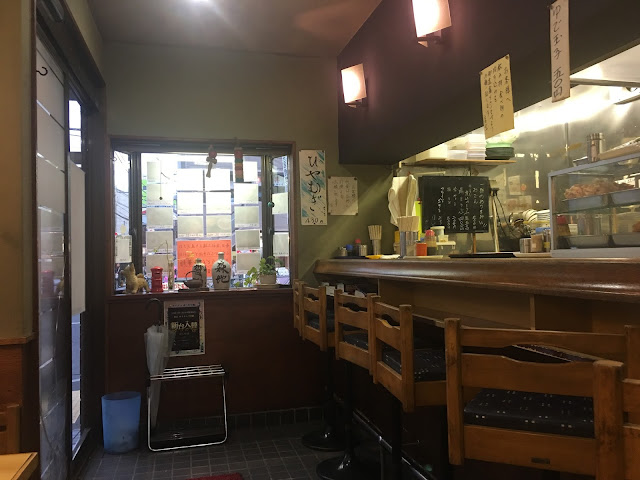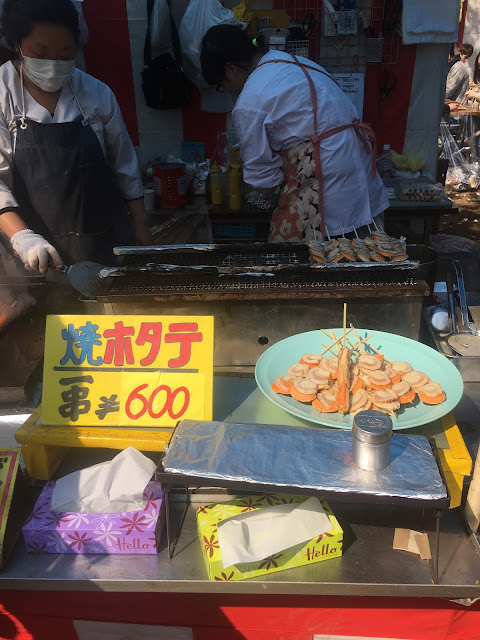The 7 Things That I Miss the Most About Japan
Optional: Jump to:
Page 1: Cherry Blossoms, vending machines, Tokyo Disneyland, Disneysea, and our little Japanese-style apartment in Arakawa where we stayed are just some of the tings that I miss the most about Japan!
3. DEPACHIKA
On our way to the Pokemon Center in Ikebukuro (not for the purpose of having our Pokemon healed, sadly speaking), we came across an exhilarating area in the basement level of a local department store called "Seibu". We were enticed by the unusual bustling of the crowd to and from the area-- not to mention, the variety of aromas that greeted us as soon as we got near.
Seibu Department Store's depachika.
I realized in awe that we unwittingly found ourselves in a place that I've only ever read about in blogs and magazines-- the Japanese food paradise called depachika, a portmanteau of the terms "depato" (department store) and "chikan" (basement), literally denoting "the basement level of a department store". The whole basement level is dedicated to food ideal for take-away like hot meals, bento boxes, delicatessen, street staples, desserts, snacks, and souvenir food stuff. It is kind of like an indoor food market-- only with more extensive offerings. All throughout Tokyo, Ikebukuro is especially well-known for its depachikas.
Mmmmm, yummy karaage.
Bento boxes and deep-fried soft-shelled crabs on display.
These are sold by the pound.
Oh, my!
Fruit cups.
Salads and desserts side-by-side.
Ebi tempura.
Various fried croquettes.
An assortment of onigiri.
Salads, rolls, and quiche.
Food to-go.
Meal sets and bentos.
Steamed siu mai and dumplings.
Chinese deli.
Mmmm, roast pork.
Seafood selection.
Only the freshest slices of fish.
Souvenir food.
Fresh ichigo cream roll.
Fish taiyaki. I especially love the tuna, matcha+custard, and matcha+red bean.
Om nom, macaroons.
Tarts and cakes.
These chicken-shaped cookies are actually popular souvenir products!
Japanese sweets.
Like I said in a previous post, the world needs more depachikas.
In the Philippines, when one is tardy, the usual excuse would be just a single word that is commonly accompanied by an indifferent attitude and a slight shrug of the shoulders: "Traffic eh." While this line of reasoning is widely considered unprofessional, the fact stands that clogging of the highways especially in the morning usually takes hours before it starts to decongest, but estimated travel time is still unpredictable. Of course there's the option of commuting, but with snail-like trains, overloaded buses, and jeepneys, not to mention the (generally) unsafe nature of the Metro, traveling to and from one place to another via any kind of automotive becomes a stressful daily chore.
The condition of the transportation system in Japan is a whole new dimension from the Philippines'. Aside from the country's major highways having virtually no traffic, there is also Japan's railway whose trains are so speedy and so efficient that a train being delayed for one minute is considered a cultural taboo; and if a train arrives five minutes late, railway officials will hand out papers that certify the train's lateness to make your tardiness valid.
Looking at the railway maps of Tokyo alone, I was totally floored by its extensiveness! While the system can be a tad confusing for first-time gaijins in the start, there's no denying how cool it is that the trains cover the whole 3,925 km2 of Greater Tokyo including some of its nearby suburbs.
A map of Tokyo's JR Lines. If these lines don't make you dizzy: congratulations! I'm not sure what else would. (Image from this link.)
The Japanese are naturally very respectful and very tidy, and these attitudes are carried over to their behavior inside the trains.While it is considered rude to speak loudly in person or in the phone while inside the train, it is perfectly acceptable to nap or sleep sitting up. This is because working men in Japan barely have enough time to sleep. In short, it is cultural norm for others to be considerate of others and maintain the environment inside the train as one conducive for rest.
Eating and drinking anything apart from water inside the trains is also a big social faux pas. As a first-time foreigner in Japan, I've noticed how the trains are incredibly clean not only on the outside but on the inside as well. That's saying something about the Japanese people's level of discipline!
The inside of a Japanese train. (Image from this link.)
How pretty! (Image from this link.)
Commuters waiting in line for their train. (Image from this link.)
Because our accommodation was located a few steps away from a Joban Line train station, we regularly used the train service to get to places listed in our itinerary. A distance that could normally be reached within a few hours worth of travel time in the Philippines can be traversed for a few measly minutes in Japan. In a country whose continuous progress is defined by its citizens' discipline, I'm not surprised at why the all-efficient train system is one of what most gaijins (including yours truly) sorely miss about Japan.
A POV walkthrough video of Ueno Park's Sakura Matsuri (Cherry Blossom Festival) featuring various Japanese festival food!
If I were to get straight to the point, I'd simply put it this way: I LOVE JAPANESE FOOD. I love how they taste, smell, and look. I love learning about how they're crafted and cooked. I love tasting them. I love eating them. As it was my first time in Japan, every single encounter that I had with a particular food item is like an open experiment-- there was no way for me to be sure if I'd like it or not except to eat it. That's not to say that I've never tasted Japanese food before, but if I were to base my past experiences on authenticity I'd say I'm somewhat of a newbie. Thankfully, though, throughout my stay in Japan, I didn't encounter a Japanese staple that I didn't like.
During our stay in Japan, we mostly ate breakfast in our apartment. I'd cook very simple breakfasts in the morning-- usually, items like toast, eggs, sausages, ham, fish, steamed rice, green tea and fruit juice are never absent from my breakfast selection. My mom and I would go out every evening to Maruetsu or Aeon to stock up on breakfast ingredients. Sometimes, we pick up a bento or three when the groceries and the convenience stores mark down their prices for the day. Where and what to eat for breakfast was never a problem for us-- it's lunch and dinner where we needed to come to a unanimous decision.
We usually had our breakfast in the tatami room.
Microwaveable omu-rice from 7-11.
Microwaveable pork tonkatsu from 7-11.
Fried smoked fish and microwaveable rice.
Bento sushi from Maruetsu.
We weren't very picky when it came to dining options. Indulging in expensive sushi or dining in Michelin-star restaurants or any pricey establishment for that matter was never our priority. We wanted our food to be as close to a typical Japanese homecooked meal as possible, which is why one of our favorite lunch and dinner option was old obaa-san's little wooden shack located right next to Mikawashima station.
Obaa-san always greeted us with a friendly “irasshai-mase” whenever we walked into her restaurant. I remember on our first visit, the old woman cheekily grinned at our amazement with her automatic sliding door, which was a huge contrast to her restaurant's old-school layout. Before we had even uttered a word, she pointed us to the window outside her shop where pictures of all the items in her menu were posted along with its respective price. Somehow, even with a huge language barrier between the two of us, her message detailing about how she takes orders from non-Japanese customers came across to me. Because we were foreigners who knew little Nihonggo and she was an old shopkeeper who understood no English, we were supposed to snap a picture of the food we wanted to order and show it to her. After our meal, she asked me if I could return all the eating materials that we used to her over the counter, and as I obeyed she handed me a damp dishcloth. It dawned on me why her food were so cheap as I began to nonchalantly wipe our table clean. We still came back about five to six more times for the food, though.
Behind this wooden counter is obaa-san, busy sifting flour for her noodles while listening to old Japanese love songs.
Proof that we were unoubtedly in Japan.
Japanese casual dining doesn't get more Japanese than this!
Some pictures of obaa-san's menu posted outside the restaurant window.
Ramen and curry rice set.
Fried pork cutlet and miso soup set.
Ramen and beef bowl set.
Shoyu ramen.
Mmmm, obaa-san's pork shoyu ramen is every ramen enthusiast's dream!
Check out the other casual dining Japanese restaurants that we visited!
This restaurant in Akihabara which uses a meal coupon vending machine and serves gigantic steins of Coke!
Pork belly bowl.
My ultimate favorite ramen: tonkotsu ramen!
Salmon sushi (wasabi optional) from a pop-up stall in Tsukiji fish market.
Mussel soup from a pop-up stall in Tsukiji fish market.
Grilled salmon set from a pop-up stall in Tsukiji fish market.
A ramen shop beneath Tokyo Station.
"How do I love thee?"
Special tonkotsu ramen.
Tonkotsu ramen.
I love ramen so much, I wish we had stopped by this cute shop in Asakusa called Buta as it offers unlimited ramen!
Although not technically a Japanese restaurant, we along with a newfound acquaintance paid Denny's a visit.
Denny's Caesar salad.
Tanuki pancake for the sweetest little girl.
Ebi tempura.
Steak and rice set.
Denny's Japanese meal set-- karaage, beancurd salad, miso soup, sauerkraut, and rice.
Beef stew.
Ultimate chocolate sundae!
Perhaps the most intimate way we got to know Japan's culture and food is by hitting the streets and sampling the country's popular street food. On our first day in Japan, we never expected that we'd be able to take part in Ueno Park's Sakura Matsuri. We couldn't help but think of how lucky we were to be at the right place at the right time to hit a mother lode of Japanese food!
Grilled salted sweetfish.
I wish I tried this!
Dango.
Okonomiyaki, a savory pancake.
Oh, joy! It's takoyaki!
This takoyaki stall is clearly family-run.
Octopus.
So now, I have my delicious food and my gorgeous view-- the only thing missing to color this scene red is you.
Potato croquettes.
Cotton candy on cute little plastic bags.
Drinks.
Grilled sausages.
Shawarma.
A liquor stand.
Japanese cake with bacon, ham, cheese, and egg.
Niku-jaga and pickles on a stick.
Grilled squid.
Edamame and oden.
Yakisoba.
Roasted corn.
Skewered chicken and beef.
Grilled skewered chicken meat-- yakitori.
Grilled skewered beef-- yakiniku.
Grilled scallops.
Turkey legs.
Choco-banana.
Grilled crab meat! Oh, my!
Candied apples, strawberries, and cherries.
Grilled seafood. Would you look at that clam?
Kakigori-- Japanese shaved ice.
Grilled manju buns.
A man making little pancakes shapes like Doraemon and Hello Kitty.
A stall selling sticky rice on a stick wrapped with bacon and grilled with a savory sauce.
Deep-fried sweet potato fries.
Anpanman candies.
Deep fried cheese sticks.
Whoever said that "absence makes the heart grow fonder" couldn't have put it better. While the feeling of missing something can leave an uncomfortable, empty, heavy feeling in one's gut, it can also be the perfect motivation to drive a person to reach out for something that his/her heart yearns so much for. And as any seasoned person can tell you-- the reunion will be much sweeter the second time around.
Cherry Blossoms, Vending Machines
Tokyo Disneyland, Disneysea
Take a peek inside a Japanese-style apartment



















































































































0 comments:
Post a Comment